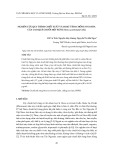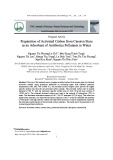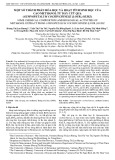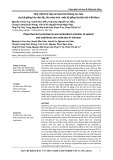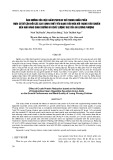
Vietnam Journal
of Agricultural
Sciences
ISSN 2588-1299
VJAS 2024; 7(3): 2228-2238
https://doi.org/10.31817/vjas.2024.7.3.05
2228
Vietnam Journal of Agricultural Sciences
Received: July 02, 2023
Accepted: September 09, 2024
Correspondence to
nguyenngoctu@vnua.edu.vn
ORCID
Nguyen Ngoc Tu
https://orcid.org/0000-0002-5411-
9846
Pollution and Potential Ecological Risk
Assessment of Heavy Metals in Water
Bodies in the Vicinity of Industrial Zones
Nguyen Ngoc Tu1,2,*, Trinh Quang Huy1, Nguyen Thi Thu Ha1,
Le Tien Hung1 & Ho Thi Thuy Hang1
1 Faculty of Natural Resources and Environment, Vietnam National University of
Agriculture, Hanoi 12400, Vietnam
2Environmental Analysis Laboratory, Center of Research Excellence and Innovation,
Vietnam National University of Agriculture, Hanoi 12400, Vietnam
Abstract
This research was undertaken to determine the concentrations of
heavy metal ions in the surface water and sediment in water bodies
that receive wastewater from the Dinh Tram and Pho Noi A industrial
zones. The pollution status of the heavy metal ions and their potential
ecological risks were evaluated by using the potential ecological risk
index (RI) and risk assessment code (RAC). The results showed that
some metal ions, namely Fe3+, Ni2+, and Pb2+, exceeded the allowed
standards of QCVN 08:2023/BTNMT. The sediments were polluted
by Zn2+, As2+, Cr6+, and Fe3+ at concentrations 2.4, 3.7, 1.9, and 2.0
times higher, respectively, than the QCVN 43:2017/BTNMT. The
potential ecological risk indices for the heavy metal ions were in
order as: (As2+) = 7.94 > (Cd2+) = 3.68 > (Cr6+) = 3.39 > (Pb2+) = 2.73
> (Cu2+) = 2.74 > (Zn2+) = 2.4 (T6 channel) and (As2+) = 11.1 > (Cd2+)
= 7.74 > (Cu2+) = 2.64 > (Cr6+) = 2.31 > (Pb2+) = 1.9 > (Zn2+) = 0.87
(Bun River). The risk assessment code (RAC) ranged from 0.17 to
39.42 (T6 channel) and from 0.03 to 38.96 (Bun River). The RAC-
based risk assessment results showed that both the T6 channel and
Bun River presented a medium risk for Cd2+, a low risk for Mn2+,
Zn2+, Cu2+, and Ni2+, and no risk for the remaining metals, Cr6+, Pb2+,
As2+, and Fe3+. These results were caused by the differences in
environmental quality assessments between using separate
parameters versus biological risk assessments.
Keywords
Ecological risk assessment, heavy metal, accumulation, sediment,
industrial wastewater
Introduction
At the end of 2020, Vietnam had 369 industrial zones, of which
90.96% of them were equipped with waste water treatment plants

Nguyen Ngoc Tu et al. (2024)
https://vjas.vnua.edu.vn/
2229
with a total capacity of more than 1.1 million m3
day-1. However, industrial zones have still had
significant impacts on the natural environment
and ecosystems surrounding these areas (Ministry
of Natural Resources and Environment, 2021).
Heavy metals, especially non-essential ones, can
have toxic impacts even at low concentrations
(Bharti & Sharma, 2022). Published literature has
shown the accumulation of heavy metal ions in
urban and industrial treated and untreated
wastewater and sediments from sites around
Vietnam. In the Nhue River, the concentrations of
Pb2+ and Zn2+ in the sediment were, respectively,
1.7 and 3.9 times higher than the allowed
standards of QCVN 43:2017/BTNMT, while the
concentrations of these ions in the water were only
a few mg L-1 (Nguyen Thi Hieu, 2013). Similarly,
in the Cau River basin, high levels of the heavy
metal ions Zn2+, Pb2+, Cu2+, and Cd2+ accumulated
in sediments at ranges of 176.4-570.7, 137.7-
436.4, 116.6-430.1, and 1.97-5.62 mg kg-1,
respectively (Duong Thi Tu Anh & Cao Van
Hoang, 2015). In the To Lich and Kim Nguu
rivers, while the concentrations of As2+, Fe3+, and
Pb2+ in the water exceeded the allowable standards
of QCVN 08-MT:2015/BTNMT column B1, the
contents of these ions in sediments were still lower
than the allowed standards of QCVN 43:
2017/BTNMT. In the Kim Nguu River, while the
concentration of Zn2+ in the surface water was
lower than QCVN 08-MT:2015/BTNMT, the
concentration of this ion in the sediment exceeded
QCVN 43:2017/BTNMT (Nguyen Thi Bich Ngoc
et al., 2015). Concentrations in the surface water
and sediments depend on the type of metal as well
as the environmental conditions. Heavy metal ions
that have accumulated in ecosystems might enter
the food chain and bioaccumulate in algae (Ngo et
al., 2009; Ngo Thi Thuy Huong et al., 2016),
crustaceans (Ngo Thi Thuy Huong et al., 2016;
Nguyen Phuc Cam Tu, 2023), and fish (Pham Kim
Dang et al., 2015). Heavy metal ions in sediments
can be introduced into the natural environment,
which can cause adverse effects on aquatic
ecosystems (Mohammed & Markert, 2006), and
account for a significant source of toxic
compounds for living organisms. The absorption
and accumulation of heavy metals in plants affect
their metabolic activity and reduce agricultural
crop yield (Guala et al., 2010). In this study, both
essential (such as Mn2+, Cu2+, Fe3+, and Zn2+) and
non-essential (such as Pb2+, As2+, Cd2+, and Cr6+)
heavy metal ions were selected to determine their
concentrations in surface water and the
corresponding sediments.
An ecological risk assessment includes an
assessment of the hazards posed by the presence
of chemicals released into the environment, and
how the environment will be affected by the
presence of one or more stressors. The potential
ecological risk index (RI) is a methodology
developed by Hakanson (1980) to evaluate the
ecological risks of heavy metals in sediments. A
risk assessment code (RAC) is a method for the
risk assessment of heavy metals (Singh et al.,
2005). Risk assessment is often based on the
chemical characteristics of heavy metals. Recent
studies have evaluated heavy metal pollution in
sediments in terms of their total content, using
total content as a criterion to assess their potential
impact on the environment. However, the total
content of heavy metals does not provide
sufficient information to assess their
bioavailability and toxicity. In this study, the
assessment results will be beneficial for the
management and control of heavy metal
pollution in both surface water and sediments in
the water bodies receiving wastewater from
industrial zones.
Methodology
The study sites were located in Bac Giang
and Hung Yen provinces, in Northern Vietnam
(Figure 1). The T6 channel and Bun River
receive wastewater from the Dinh Tram and Pho
Noi A industrial zones (IZ), respectively. Both
Dinh Tram (2,000 m3 day-1 of wastewater
discharged) and Pho Noi A (6,000 m3 day-1 of
treated wastewater discharged) mainly include
electronic component manufacturing and
mechanical factories. Since the T6 channel and
Bun River are water channels for agricultural
irrigation, it is very important to control the
quality of surface water resources.

Pollution and potential ecological risk assessment of heavy metals in water bodies in the vicinity of industrial zones
2230
Vietnam Journal of Agricultural Sciences
Research Materials
Water samples
Seven surface water samples were collected
at the T6 channel (M1-M4), which receives
wastewater from the Dinh Tram industrial zone,
and the Bun River (M5-M7), which obtains
wastewater from the Pho Noi A industrial zone,
in March of 2023. The surface water samples for
Figure 1
. Study sites
Table 1. Locations for sampling surface water
No
Location
Coordinates
Note
M1
Dinh Tram IZ
21°15'47.9"N
106°07'28.5"E
In the sewer
M2
Dinh Tram IZ
21°15'50.8"N
106°07'29.6"E
100m from the sewer
M3
Dinh Tram IZ
21°15'49.8"N
106°07'35.0"E
400m from the sewer
M4
Dinh Tram IZ
21°15'52.2"N
106°07'25.2"E
Irrigation drain to Duc Lien
M5
Pho Noi A IZ
20°57'14.5"N
106°01'55.2"E
In the sewer
M6
Pho Noi A IZ
20°57'06.9"N
106°02'15.6"E
600m from the sewer
M7
Pho Noi A IZ
20°57'02.7"N
106°02'27.2"E
Irrigation drain to Chua village
Figure 2.
Sampling sites

Nguyen Ngoc Tu et al. (2024)
https://vjas.vnua.edu.vn/
2231
the experiment were collected following TCVN
6663-1:2011. Samples were taken from the shore
with a stick and water sampler device at a depth
of 20cm below the water level and placed in cold
storage in a 1 liter, dark-colored container. The
detailed information on the surface water
samples is described in Table 1 and Figure 2.
Sediment samples
The locations of sediment sampling were the
same sites as the surface water sampling.
Sediment samples were collected by using an
Ekmans bucket 196-F62 with a capacity of 5.3
liters. The sediment samples for the experiment
were collected following TCVN 6663-15:2004.
The samples were collected at a 0-10cm depth in
the sediment-water interface and stored in plastic
containers. Large particles and debris were
removed via 2mm sieves, air-dried, and then
homogenized before analyzing.
Research Methods
Sequential extraction concentration (F1, F2)
of heavy metal ions
Heavy metal ion concentrations were
fractionated into two parts, F1 and F2, following
the methods of Tessier et al. (1979). The
sequential extraction procedure is shown in
Figure 3.
Heavy metal concentration analysis
Heavy metals in the surface water were
directly analyzed by US EPA Method 3051
(microwave-assisted acid digestion) and US EPA
Method 6020A (inductively coupled plasma
mass spectrometry). Five milliliters of each
surface water sample was mixed with 10ml of
aqua-regia solution (HNO3:HCl=1:3) and then
slowly heated to 200oC in a microwave digestion
system. Sediment samples were air-dried and
then passed through a 2mm sieve. Two grams of
each dried sediment sample was mixed with
20ml H2O2 to remove any organic matter, then
mixed with 10ml of1M CH3COONH4 solution,
and slowly heated to 200oC in a microwave
digestion system. The extracted solution after
digestion was examined by inductively coupled
plasma mass spectrometry (ICP-MS). All
experiments were performed in triplicate.
Ecological risk assessment (RI)
A potential ecological risk index (RI) was used
as a diagnostic tool for water pollution assessment
purposes. The index was recommended by
Hakanson (1980). The value of RI can be
calculated by the following formulas and is
clarified in Table 2:
𝐶
𝑓
𝑖=𝐶𝐷
𝑖
𝐶𝑅
𝑖; 𝐸𝑟
𝑖= 𝑇
𝑟
𝑖 × 𝐶
𝑓
𝑖 and 𝑅𝐼 =∑𝐸𝑟
𝑖
𝑚
𝑖=1
Figure 3.
Sequential extraction of heavy metals (Tessier et al., 1979)

Pollution and potential ecological risk assessment of heavy metals in water bodies in the vicinity of industrial zones
2232
Vietnam Journal of Agricultural Sciences
Table 2. Indices and grades of potential ecological metal contamination
𝑬𝒓
𝒊
Grade of ecological risk of a single metal
RI value
Grade of potential ecological risk of environment
𝐸𝑟
𝑖<40
Low risk
RI < 150
Low risk
40≤ 𝐸𝑟
𝑖<80
Moderate risk
150 ≤ RI < 300
Moderate risk
80 ≤ 𝐸𝑟
𝑖<160
Considerable risk
300 ≤ RI < 600
Considerable risk
160 ≤ 𝐸𝑟
𝑖<320
High risk
RI ≥ 600
Very high risk
𝐸𝑟
𝑖≥320
Very high risk
-
Table 3. Classification of RAC (%)
No
Metal ions in the exchangeable (F1) and carbonate-bound (F2) fractions
Risk
1
< 1
No risk
2
1-10
Low risk
3
11-30
Medium risk
4
31-50
High risk
5
> 50
Very high risk
where RI is the sum of potential risks of an
individual heavy metal; Er
i is the potential risk of
an individual heavy metal; Tr
i is the toxic-
response factor for a given heavy metal
(Hakanson, 1980); Cf
i is the contamination
coefficient; CD
i is the present concentration of
heavy metals in the sediments; and CR
i is the pre-
industrial record of heavy metal concentration in
the sediments.
Risk assessment code (RAC)
Risk assessment code (RAC) is defined as the total
fraction of exchangeable (F1) and carbonate-bound
(F2) metals. According to the guidelines of the
RAC method, for any metal, where the total
fractions of exchangeable and carbonate-bound
are less than 1%, there is no risk, but when this
ratio is greater than 50%, the level of risk is
assessed as very high and heavy metals are easily
able to be released and enter the food chain. The
level of risk to the ecosystem was assessed based on
two types of fractions, exchangeable (F1) and
carbonate-bound (F2), through the %RAC index
(Perin et al., 1985) as shown in Table 3.
Results and Discussion
Heavy metal in surface water
The results of the heavy metal ion
concentrations in the surface water are
summarized in Table 4. In general, some heavy
metal concentrations, namely Cu2+, Zn2+, As2+,
and Cd2+, were still below the permissible
standard thresholds, while others, namely Pb2+,
Mn2+, Ni2+, Cr6+ and Fe3+, were from 1.1 to 4.7
times higher than the allowed standards. Surface
water in the T6 channel and Bun River were not
polluted by Cu2+, Zn2+, As2+, Mn2+, Cr6+, or Cd2+
in comparison with the National Technical
Regulations on surface water quality - QCVN
08:2023/BTNMT. However, the concentrations
of some ions, namely Fe3+ and Ni2+, exceeded the
allowed standards. The surface water was polluted
by Fe3+ and Ni2+ at approximately 1.62 and 1.2
times as much as QCVN 08:2023/BTNMT.
Iron (Fe) had 6/7 samples while Ni2+ and
Pb2+ had only 1/7 locations that exceeded the
allowed standards. The locations that exceeded
the standards were all located in the wastewater
sewer of the industrial zones. The remaining
locations adjacent to the agricultural area (M3 ,
M4, and M7) were within the allowed standards.
The high concentration of Fe3+ might be explained
by the application of ferric sulfate
(Fe2(SO4)3.nH2O) as an iron-based coagulant in
wastewater treatment systems (Rizzo et al.,
2008) in both industrial zones.
Heavy metal contents in sediment
The results analyzing the heavy metal ions
in the sediments are summarized in Table 5.
The concentrations of heavy metals in
the sediment samples were compared with the




